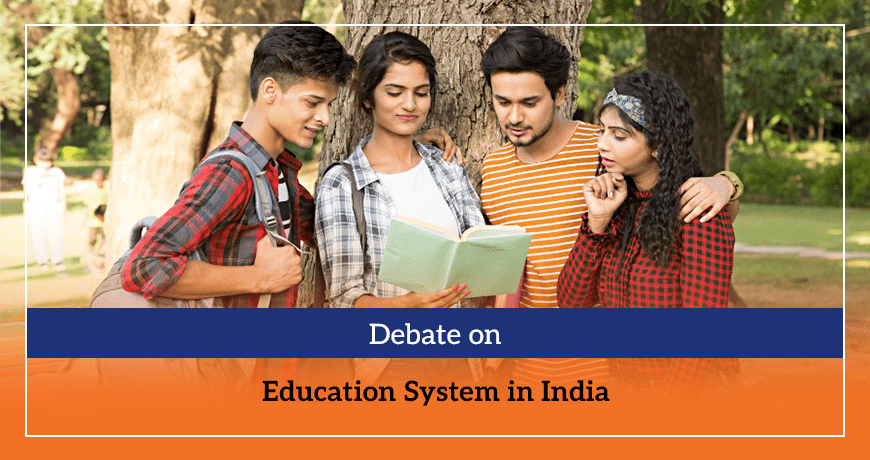Selecting the right educational curriculum is essential as it can impact your learning journey and prospects. This choice can become even more critical when considering the ongoing debate between two prominent systems: the Indian curriculum vs British curriculum.
Both curriculums have distinct approaches to teaching and learning. They foster unique strengths and cater to different learning styles. In this write-up, we will dig into the core characteristics of each curriculum and highlight their advantages and disadvantages. So, let's begin.
Understanding the UK Education System vs Indian Education System
Structure
- UK: The UK education system is divided into four stages: primary (ages 5-11), secondary (ages 11-16/18), further (vocational training or A-Levels for university preparation), and higher education (universities). Students have more flexibility in subject choices, particularly after primary school.
- India: The Indian system follows a more rigid structure: primary (ages 6-14), secondary (ages 14-16), higher secondary (ages 16-18), and higher education (universities). Subject choices are limited, with a strong emphasis on core academics.
Teaching Methods
- UK: The UK system emphasises interactive learning. It encourages critical thinking, problem-solving, and independent research. Teachers are facilitators, guiding students to explore concepts and develop their understanding.
- India: The Indian system traditionally relies on teacher-centred instruction where rote memorisation plays a significant role. However, there's a growing focus on incorporating more activity-based learning and encouraging classroom discussions.
Assessment Styles
- UK: The UK system utilises various assessment methods, including essays, projects, presentations, and standardised tests. Continuous assessments throughout the year contribute to final grades, promoting a well-rounded understanding.
- India: The Indian system heavily emphasises high-stakes, standardised exams at the end of each stage. Rote memorisation often takes precedence over a deeper understanding of concepts.
Key Differences
- Focus: The UK system prioritises critical thinking and independent learning, while the Indian system emphasises memorisation and standardised tests.
- Flexibility: The UK curriculum offers more flexibility in subject choices, catering to individual interests. The Indian curriculum is more rigid.
- Technology Integration: UK schools generally focus more on integrating technology into learning.
Similarities
- Stages: Both systems have a similar progression through primary, secondary, and higher education.
- Importance of Exams: Exams play a significant role in both systems for progression to higher education.

Debate on Education System in India: Exploring Perspectives
The Indian education system is a boiling pot of diverse opinions. While some hail it for producing high-achieving graduates, others criticise its rigid structure and rote learning emphasis.
One of the most prominent battle cries concerns rote learning, where students memorise facts and figures without understanding the underlying concepts. Critics argue this approach limits creativity, critical thinking, and the ability to use intuitions in real-world scenarios.
They advocate for a shift towards a more analytical and problem-solving-oriented education. However, supporters of the traditional system highlight the necessity of a strong foundation in core subjects. They believe rote learning equips students with the necessary knowledge base for higher education and competitive exams.
Another point of contention centres on the lack of practical education. The curriculum, some argue, focuses heavily on theoretical knowledge, leaving students unprepared for the demands of the modern workforce.
They call for a more skills-based approach, incorporating vocational training, project-based learning, and internships to equip students for future success. Opponents of this view suggest that the current system prioritises well-rounded individuals with a strong foundation in various subjects, allowing them to adapt to diverse career paths.
Cultural inclusivity also sparks debate. Critics argue that the current curriculum often prioritises a dominant culture, neglecting the experiences and perspectives of diverse ethnicities and religions.
They advocate for a more inclusive curriculum that celebrates India's rich tapestry and fosters a sense of belonging for all students. Traditionalists, however, express concerns about compromising the integrity of a national curriculum and the importance of fostering a shared national identity.

Difference Between Indian Education and Foreign Education: A Comprehensive Comparison
Curriculum Structure
The Indian system follows a more rigid structure. It strongly emphasizes core subjects like mathematics, science, and language. Students have limited choices in subject selection, particularly after primary school. This approach aims to create a well-rounded foundation but can limit opportunities to explore individual interests.
In contrast, the UK system offers greater flexibility. Students have more freedom in choosing subjects, especially after primary education. It allows for earlier specialisation and caters to individual learning styles and aspirations.
Pedagogical Approaches
Traditional Indian classrooms are often teacher-centred, with rote learning and memorisation playing a significant role. Teachers act as knowledge providers, delivering information through lectures and expecting students to absorb and reproduce it. However, a growing movement emphasises more interactive methods to encourage critical thinking and independent learning.
The UK system prioritises a student-centred approach. Teachers act as facilitators, guiding students towards independent research, critical thinking, and active participation in discussions. Project-based learning and group work are more prevalent, fostering collaboration and communication skills.
Assessment Styles
Examinations play a central role in both systems for progression to higher education. However, the nature of the assessment differs significantly. The Indian system relies heavily on high-stakes standardised exams, with success hinging on a student's ability to recall vast amounts of information.
The UK system utilises a broader range of assessments, including coursework, projects, presentations, and exams. This approach evaluates students' ability to apply knowledge, analyse problems, and demonstrate critical thinking skills beyond rote memorisation.
Global Recognition
A foreign degree, particularly from a prestigious UK university carries greater global recognition than an Indian degree. It can be advantageous for students seeking international careers or pursuing higher education abroad.
However, the reputation of Indian Institutes of Technology (IITs) and Indian Institutes of Management (IIMs) is growing, offering strong alternatives in specific fields.
Merits of Education System in India: Identifying Strengths
Affordability: Education for All
One of the most significant merits of the Indian system is its affordability. Public schools offer low-cost education, making it accessible to most of the population. It promotes social mobility and allows students from diverse backgrounds to pursue academic goals. Government scholarships and affirmative action programs further ensure inclusivity and provide opportunities for underprivileged students.
Cultural Tapestry: A Celebration of Diversity
India's rich cultural heritage is woven into the fabric of its education system. Students are exposed to many languages, religions, and traditions, fostering tolerance, understanding, and a sense of national identity. This exposure equips them to navigate an increasingly globalised world and appreciate diverse perspectives.
Academic Rigor: Building a Strong Foundation
The Indian curriculum emphasises a strong foundation in core subjects like mathematics, science, and language. This rigour prepares students for competitive higher-education entrance exams, particularly engineering and medicine. The world recognises Indian Institutes of Technology (IITs) and Indian Institutes of Management (IIMs) for their academic excellence, attracting talented students and producing world-class graduates.
Focus on Values: Building Character With Knowledge
The Indian education system traditionally emphasises inculcating moral values and ethical principles. Respect for elders, teachers, and cultural heritage is emphasised alongside academic pursuits. It helps to become well-rounded individuals with a strong sense of responsibility and social awareness.
A System in Evolution: Embracing Change
The Indian education system is not static. A growing recognition of the need for reform is leading to positive changes. There's a push for more interactive teaching methods, skill-based learning, and technology integration into the classroom. These advancements aim to equip students with the necessary skills to thrive in the job market now.

Exploring the Indian Education System: Structure and Characteristics
A Historical Perspective
The roots of the Indian education system can be traced back to ancient times, with a strong emphasis on gurukul-based learning and religious scriptures. The arrival of the British in the 18th century introduced a Westernised system focused on the English language and administration.
After independence, India embarked on a journey to create a national education system that catered to its vast population and diverse needs. This journey continues to evolve, with ongoing debates about pedagogy, inclusivity, and preparing students for the 21st century.
Structure and Stages
The Indian education system follows a 10+2+3 structure, divided into four main stages:
- Primary Education (Ages 6-10): This stage emphasises foundational literacy, numeracy, and basic life skills. It is further divided into lower primary (grades 1-5) and upper primary (grades 6-8).
- Secondary Education (Ages 11-14): This stage focuses on core subjects like mathematics, science, social science, and languages. Students can choose between a general stream or a vocational stream.
- Higher Secondary Education (Ages 15-18): This stage offers more specialisation in streams like Science, Commerce, and Arts. Students prepare for competitive entrance exams for higher education.
- Higher Education (Age 18+): This stage encompasses universities, colleges, and institutes offering professional degrees and postgraduate studies.
The Curriculum Framework
The curriculum is centrally designed, with some flexibility allowed at the state level. It emphasises core subjects like mathematics, science, social studies, and languages. However, concerns exist regarding limited space for creativity, critical thinking, and practical skills development.
Examination System: A High-Stakes Arena
Examinations play a pivotal role in the Indian education system. Standardised tests determine progression to higher stages and university admissions. This high-stakes environment can lead to rote learning and focusing on memorisation over deeper understanding.
Challenges and Considerations
Several challenges persist within the Indian education system:
- Teacher Training and Resources: A need exists for improved teacher training and infrastructural development in many schools.
- Social Disparity: Access to quality education remains unequal, particularly for underprivileged communities in rural areas.
- Skill Gap: The curriculum might not adequately address the growing need for 21st-century skills like critical thinking and problem-solving.
Advantages & Disadvantages of the Indian Curriculum
Advantages of the Indian Curriculum:
- Strong Basics: Focuses on building a solid foundation in core subjects like math and science.
- Affordable: Education is generally more affordable, making it accessible to a larger population.
- Cultural Diversity: Promotes cultural values and diversity.
- Moral Education: Emphasizes moral values and ethics.
Disadvantages of the Indian Curriculum:
- Memorization: Relies heavily on rote learning, which can limit creative thinking.
- Limited Choices: Offers fewer choices in subjects, which might not cater to every student's interests.
- Stressful Exams: High-pressure exams can cause stress among students.
- Lack of Practical Skills: Often focuses less on practical skills and hands-on learning.

Education System in the UK: An Insightful Examination
Navigating the Stages
The UK system is divided into four key stages:
- Primary Education (Ages 5-11): This stage lays the foundation for literacy, numeracy, and social development through play-based learning and exploration.
- Secondary Education (Ages 11-16/18): Students follow a core curriculum with increasing opportunities for specialisation, culminating in exams like GCSEs. Some students continue until age 18 for A-Levels, preparing for university.
- Further Education (Ages 16-18+): This stage offers vocational training, apprenticeships, or A-Levels for university entrance.
- Higher Education: Universities provide undergraduate and postgraduate degrees, strongly emphasising research and specialisation.
Curriculum and Standards
The UK curriculum sets national standards for core subjects like English, mathematics, science, and history. However, schools have some flexibility in tailoring the curriculum to their specific context and student needs. While standardised testing exists, it plays a less dominant role compared to other countries.
Emphasis on Methodology
Teaching methodologies in the UK prioritise student engagement and active learning. Teachers act as facilitators, encouraging discussions, critical thinking, and independent research. Project-based learning, group work, and technology integration are increasingly utilised to enhance the learning experience.
Strengths on the Global Stage
The UK education system boasts several strengths:
- Flexibility and Choice: Students have more freedom in subject selection, catering to individual interests and fostering a well-rounded skillset.
- Focus on Critical Thinking: The emphasis on analytical skills and independent learning equips students to thrive in a knowledge-based economy.
- Globally Recognised Qualifications: UK degrees are highly respected worldwide, opening doors for international careers and further education.
- Multicultural Environment: The UK education system is diverse, attracting students worldwide and fostering a global perspective.
Challenges and Considerations
The UK system also faces challenges:
- Social Inequality: Unequal access to quality education persists, with socioeconomic background impacting student opportunities.
- High-Stakes Testing: While less dominant than in other countries, standardised testing can still create pressure and limit the focus on broader skill development.
- Funding Issues: Schools face funding pressures, impacting resources and teacher training opportunities.
Advantages & Disadvantages of the British Curriculum
Advantages of the British Curriculum
- Critical Thinking: Encourages critical thinking and independent learning.
- Flexible: Offers a wide range of subjects, allowing students to explore different interests.
- Various Assessments: Uses different types of assessments, not just exams.
- Global Recognition: Qualifications are recognized and respected worldwide.
Disadvantages of the British Curriculum
- Costly: Can be expensive, especially for international students.
- Inequality: May contribute to social inequality due to different levels of access and resources.
- Testing Pressure: Standardized testing can create pressure.
- Funding Issues: Sometimes lacks sufficient funding, affecting resources and facilities.
Choosing the Right Curriculum: Navigating Educational Options
Understanding Yourself
- Learning Style: Do you thrive in a teacher-centred environment or benefit from a more hands-on, interactive approach? The UK system's emphasis on independent learning might suit a self-motivated student, while the Indian system's structure could benefit someone who prefers clear guidance.
- Strengths and Interests: Consider your natural abilities and academic passions. The UK system's flexibility allows for earlier specialisation, while the Indian system offers a strong foundation in core subjects.
Educational Goals
- University Aspirations: If you aim to pursue higher education abroad, a UK qualification might be advantageous due to its global recognition. However, top Indian institutions like IITs and IIMs also hold significant weight in specific fields.
- Career Path: The UK system's emphasis on critical thinking and communication skills can benefit careers in diverse fields. The Indian system's focus on core subjects might suit engineering, medicine, or other science-based professions.
Lifestyle Considerations
- Adaptability: Moving to a new country requires significant adjustment. Consider if your child thrives in new environments or prefers familiarity. The UK system would demand adapting to a different cultural context.
- Financial Resources: The Indian system offers a cost-effective option while studying abroad in the UK incurs tuition fees and living expenses.
Must Read: Why Study in UK NOT in India
Indian Curriculum vs British Curriculum: Which Is Better?
Choosing the best curriculum depends on several factors:
- Learning Style: The Indian curriculum is good for strong basics, while the British curriculum fosters critical thinking.
- Goals: If you want global recognition and flexibility, the British system might be better. For strong cultural and moral values, the Indian system is a good choice.
- Costs: Consider the cost and accessibility; the Indian curriculum is generally more affordable.
- Overall Fit: Think about your child's individual needs and future aspirations to decide which curriculum suits them best.
Conclusion
The educational journey is a unique path for each individual. The Indian and British Curriculums offer distinct approaches to education. The Indian system emphasises a strong foundation in core subjects and memorisation, while the British system prioritises critical thinking, independent learning, and a wider range of subject choices. After knowing the differences between the Indian Curriculum vs British curriculum, now you can decide on your own.